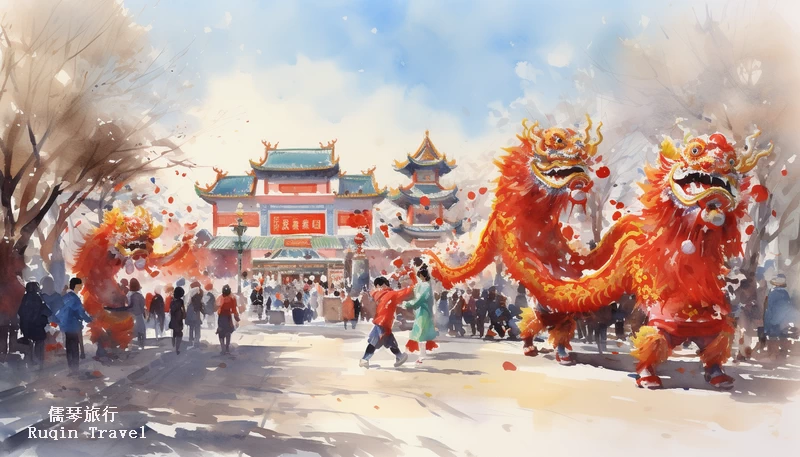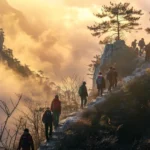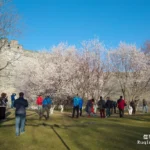Visiting Beijing in February offers a unique blend of late winter charm and the beginning of vibrant cultural festivities. This month is a transitional period when the city slowly thaws from winter’s grip and begins to embrace the early signs of spring.
This guide is designed for first-time visitors to visit Beijing in February. It provides essential tips on how to navigate the city’s weather, explore its attractions, and experience its cultural events.
February Weather in Beijing
February marks the transition from harsh winter to the milder onset of spring in Beijing. Temperatures typically range from a high of 5°C to a low of -7°C. While it’s slightly warmer than January, the weather remains cold, with persistent winds and dry air. However, you can still enjoy many sunny days.
Indoor spaces are comfortably warm, thanks to efficient heating systems in hotels, restaurants, and public transportation. Yet, when you step outside, you’ll feel the brisk, lively air of Beijing’s streets.
What to Wear and Pack in February
When you are going to visit Beijing in February, focus on warmth and comfort. Layered clothing is essential for adapting to the varying temperatures between indoors and outdoors. Key items include cotton coats, down jackets, leather jackets, woolen coats, hats, and gloves. On particularly cold days, a fur coat may be necessary. Indoors, lighter clothing like sweaters or T-shirts will be sufficient due to the reliable heating.
If you prefer not to bring heavy winter clothes from home, Beijing’s shopping scene offers plenty of options. Department stores and markets, such as the famous Silk Street Market, provide a wide range of winter apparel. Shopping in these areas also gives you a chance to experience local culture.
Historical Climate Data and Preparation in February
Understanding the historical climate data for February is crucial for planning your trip. Data reflecting weather trends over the past 50 years can help you anticipate conditions and pack accordingly. This information is particularly valuable for ensuring you bring the right clothing and gear.
| Date | Average High (°C) | Average Low (°C) | Extreme High (°C) | Extreme Low (°C) |
|---|---|---|---|---|
| February 01 | 2 | -8 | 12℃ (1976) | -16℃ (1965) |
| February 02 | 2 | -8 | 11℃ (2002) | -16℃ (1972) |
| February 03 | 3 | -8 | 13℃ (2007) | -16℃ (1952) |
| February 04 | 3 | -8 | 12℃ (2002) | -15℃ (1963) |
| February 05 | 3 | -8 | 16℃ (2007) | -17℃ (1969) |
| February 06 | 4 | -7 | 16℃ (1993) | -18℃ (1953) |
| February 07 | 4 | -7 | 15℃ (1995) | -16℃ (1968) |
| February 08 | 4 | -7 | 13℃ (1987) | -15℃ (1957) |
| February 09 | 4 | -7 | 15℃ (2007) | -16℃ (1957) |
| February 10 | 5 | -7 | 16℃ (1987) | -14℃ (1967) |
| February 11 | 4 | -7 | 13℃ (1995) | -15℃ (1968) |
| February 12 | 5 | -7 | 14℃ (1981) | -14℃ (1967) |
| February 13 | 6 | -6 | 20℃ (1996) | -13℃ (1964) |
| February 14 | 5 | -6 | 15℃ (1996) | -13℃ (1980) |
| February 15 | 5 | -6 | 13℃ (1966) | -15℃ (1953) |
| February 16 | 4 | -6 | 15℃ (1974) | -15℃ (1953) |
| February 17 | 5 | -6 | 15℃ (1974) | -14℃ (1952) |
| February 18 | 5 | -6 | 14℃ (1979) | -13℃ (1953) |
| February 19 | 5 | -5 | 16℃ (1960) | -14℃ (1957) |
| February 20 | 5 | -5 | 15℃ (1962) | -13℃ (1968) |
| February 21 | 5 | -5 | 16℃ (2002) | -14℃ (1968) |
| February 22 | 6 | -5 | 15℃ (1963) | -27℃ (1966) |
| February 23 | 6 | -5 | 17℃ (1977) | -23℃ (1966) |
| February 24 | 5 | -5 | 17℃ (1977) | -19℃ (1969) |
| February 25 | 5 | -4 | 16℃ (1992) | -16 |
Continuing from where we left off, here’s the remainder of the Historical Climate Data for February in Beijing:
| Date | Average High (°C) | Average Low (°C) | Extreme High (°C) | Extreme Low (°C) |
|---|---|---|---|---|
| February 26 | 6 | -4 | 18℃ (1992) | -14℃ (1981) |
| February 27 | 7 | -4 | 17℃ (1992) | -14℃ (1969) |
| February 28 | 7 | -4 | 19℃ (1963) | -13℃ (1969) |
| February 29 | 7 | -3 | 14℃ (2008) | -10℃ (1956) |
In addition to warm clothing, consider packing moisturizers and lip balms to counter the dry weather. Staying hydrated is also important while you explore the city.
February Events, Holidays, and Festivals
Beijing in February is not just a city experiencing the tail end of winter; it’s a cultural hub buzzing with excitement and tradition. This month is particularly special due to its blend of traditional festivals and modern celebrations. Here’s a closer look at some key events, holidays, and festivals you can experience during your visit:
1. Spring Festival (春节, Chun Jie) – Jan 28- Feb 4, 2025
Public Holiday: This 7-day holiday is China’s most significant festival, celebrating the lunar new year, the year of Snake. It’s a time of joyous gatherings, cultural performances, and various traditional activities.
Traditions: The festival is replete with lion dances, dragon dances, and the giving of red envelopes (hongbao) containing money, symbolizing good luck and blessings.
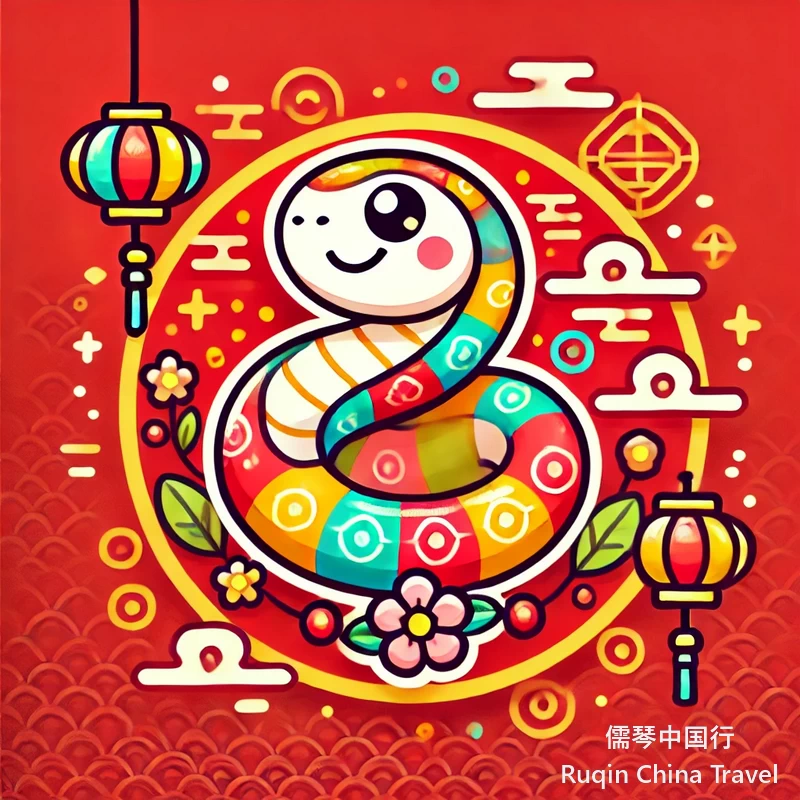
2. Beijing Spring Festival Temple Fair Guide 2025
The Beijing Spring Festival Temple Fairs are a beloved tradition, offering cultural experiences, performances, and festive activities. Here’s your guide to the dates and locations of this year’s temple fairs:
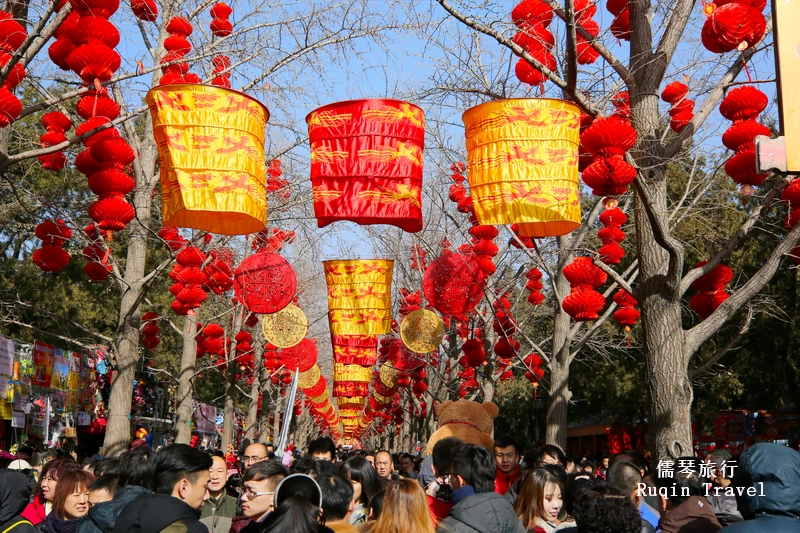
| Temple Fair | Dates | Location | Highlights |
|---|---|---|---|
| Ditan Temple Fair (地坛庙会) | January 30 – February 4 (2nd to 7th day of the Lunar New Year) | Ditan Park | Watch Qing Dynasty-style earth worship, folk flower ceremonies, traditional dances, and acrobatics. |
| Longtan Temple Fair (龙潭庙会) | January 29 – February 4 (1st to 7th day) | Longtan Park | Enjoy the Ice and Snow Festival, a Chinese-style e-sports carnival, and an interactive chess area. |
| Changdian Temple Fair (厂甸庙会) | January 29 – February 2 (1st to 5th day) | East and West Liulichang, Xicheng District | Discover antique exhibitions, book fairs, and intangible cultural heritage displays. |
| Daguan Garden Red Mansion Temple Fair (大观园红楼庙会) | January 29 – February 2 (1st to 5th day) | Daguan Garden | Step into an immersive “Red Mansion” environment with thematic “Reunion” settings. |
| Badachu Spring Festival Cultural Temple Fair (八大处新春文化庙会) | January 29 – February 5 (1st to 8th day) | Badachu Park | Explore the traditional market, sample local snacks, and enjoy folk performances. |
These temple fairs are an essential part of the Spring Festival celebrations in Beijing, offering a mix of cultural experiences, entertainment, and delicious food.
3. Start of Spring (立春, Li Chun) – Feb 04, 2024:
Significance: Marking the first of the 24 solar terms in the traditional Chinese lunar calendar, Li Chun symbolizes the beginning of spring. It’s a time when nature slowly awakens, with a noticeable shift towards warmer weather and greener landscapes.
Activities: Although not a public holiday, it’s a day imbued with optimism and renewal. Locals might engage in traditional practices like biting the spring (咬春) or eating spring pancakes, embracing the season’s arrival.
4. Rain Water (雨水, Yu Shui) starting on Feb 19:
Cultural Importance: Another solar term indicating the start of increased rainfall and rising temperatures, signaling that spring is on the horizon.
Observance: While not celebrated with specific activities, it’s a time when farmers traditionally begin preparing for the spring planting, and it’s noted for its agricultural significance.
Lantern Festival (元宵节, Yuan Xiao Jie) – Feb 12, 2025:
Lantern Displays: The festival is best known for its stunning lantern displays, where intricate and colorful lanterns light up the night sky.
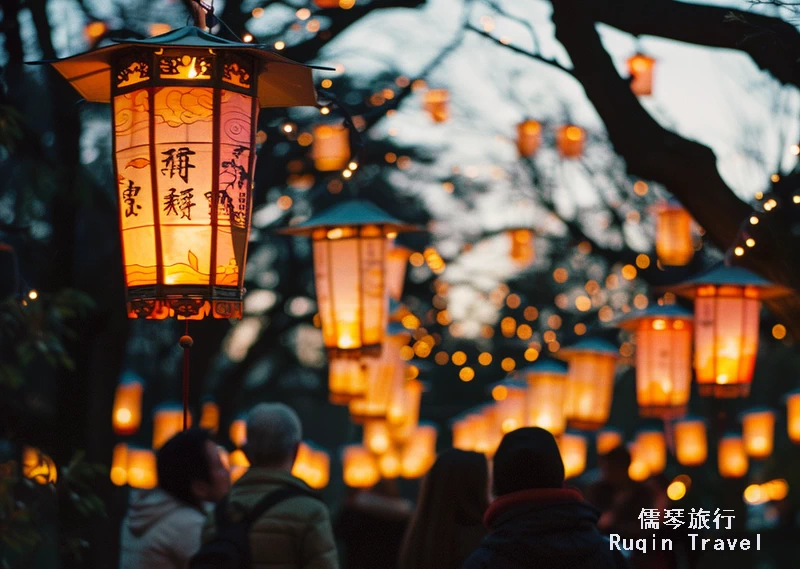
5. Shichahai Ice Skating Rink
The Shichahai Ice Skating Rink is a must-visit spot in the first half of February. Located in the scenic Shichahai Area, near Qianhai and Houhai in Shichahai Area, it offers a magical winter experience. The rink is open from January 5th to February 10th, depending on the weather, and operates daily from 9:00 AM to 8:30 PM.
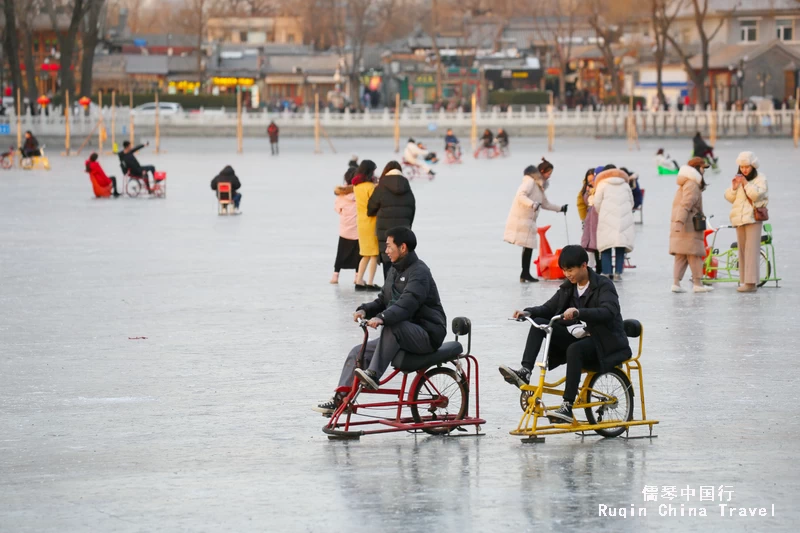
This is a fun and affordable way to enjoy Beijing’s winter. Whether you’re a beginner or an experienced skater, the rink provides a supportive environment for all skill levels. Don’t forget to dress warmly, as the cold can be biting. If you don’t have your own skates, you can easily rent them on-site.
The beautiful winter views of Houhai Lake add to the charm, making it a perfect spot for photos. If you’re looking to embrace the season, this rink offers a memorable experience in a picturesque setting.
6. Ski Resorts in Beijing
If you’re looking for adventure, Beijing’s ski resorts are the place to be. They offer something for everyone, from beginners to experts. You can enjoy skiing, snowboarding, and even tobogganing. Popular resorts like Nanshan Ski Village, Huaibei International Ski Resort, and Yuyang Ski Resort are all great choices.
For more information on ski resorts in Beijing, check out Best Ski Resorts in Beijing for more information.
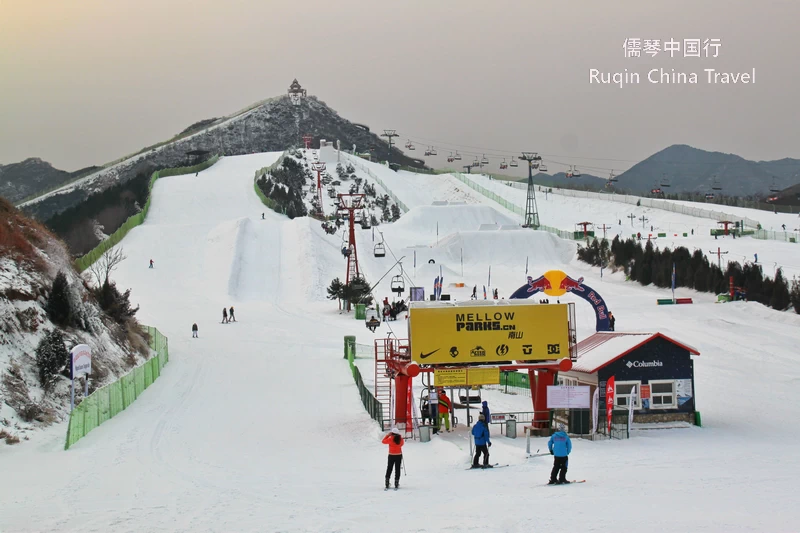
Even if skiing isn’t your thing, the resorts still offer plenty of options. You can relax in cozy cafes, sip warm drinks, and enjoy the beautiful snowy landscapes. It’s a perfect escape for anyone seeking a winter retreat.
7. Birdwatching in Beijing
February is a fantastic time for birdwatching in Beijing. The city’s parks and nature reserves come alive with diverse bird species. It offers a peaceful retreat from the hustle and bustle of the city.
Some top birdwatching spots include Yeyahu Lake (Wild Duck Lake) and the Sahe Reservoirs in Changping District. These locations are home to both resident and migratory birds, providing excellent opportunities for spotting unique species. Bring binoculars and enjoy the tranquil environment as you observe birds in their natural habitat. It’s a rewarding way to connect with nature while visiting Beijing.
Best Sections of the Great Wall to Visit in Winter
There are several sections of the Great Wall that are accessible from Beijing. Each offers a unique experience, especially in winter. Check out: Great Wall of China in winter from Beijing
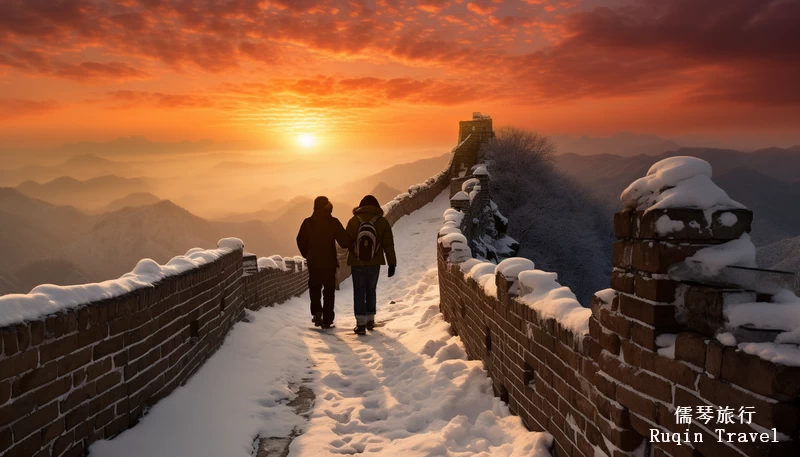
Mutianyu Great Wall
Mutianyu is one of the best-preserved sections of the Great Wall. It is also less crowded than the popular Badaling section. In winter, the snow-covered Wall at Mutianyu is a sight to behold.
The cable car and chair lift make it easier to access, and the toboggan ride down is an exhilarating experience. Check Out: How to Get to Mutianyu Great Wall
Badaling Great Wall
Badaling is the most famous and visited section of the Great Wall. While it can be crowded during peak seasons, winter sees fewer visitors. How to Get to Badaling Great Wall
The Wall at Badaling is well-restored and offers stunning views. The Great Wall Museum and the circular screen cinema provide additional attractions.
Jinshanling Great Wall
For a more rugged and authentic experience, Jinshanling is an excellent choice. This section is partially restored, giving you a glimpse of the Wall’s original condition. How to Get to Jinshanling Great Wall
The snow-covered towers and battlements create a dramatic scene. However, this section requires more physical effort to explore, so be prepared for a challenging hike.
Visiting Beijing in February allows you to experience a city in transition, not just in terms of weather but also in its cultural heartbeat. From traditional festivities that have been celebrated for centuries to modern recreations and outdoor activities, February in Beijing is a month rich with experiences, colors, and traditions. It’s a time when the city is not just seen but truly felt, as each festival and event tells a story of China’s rich heritage and vibrant community spirit.
More Beijing Travel Guides
Planning your Beijing tour? Our “Beijing Travel Guide“ section offers essential advice to help you navigate the city like a pro. From transportation tips and local customs to insider recommendations for hidden gems, these travel tips will ensure you have a smooth, enjoyable, and unforgettable experience in China’s vibrant capital. Let us guide you through the best practices for exploring Beijing with confidence!

